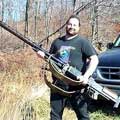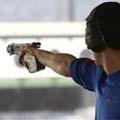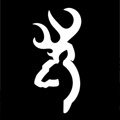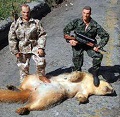Curiosity
20 posts
• Page 1 of 1
Curiosity
At the end of a post why do people list what firearms they own?
- ToyotaBoy
- Recruit

- Posts: 43
- Victoria
Re: Curiosity
Just so people know the stuff you're familiar with or regularly shoot.
CZ 550 American Safari Magnum in .416 Rigby
Other puny calibre rifles... What man would want you now?
Other puny calibre rifles... What man would want you now?
-

Norton - Staff Sergeant

- Posts: 838
- Queensland
Re: Curiosity
That's pretty much it.
If you want to talk to someone about Tikka's the guy with 3 Tikka's in his signature is a good start
There is no obligation to do this of course. If you're uncomfortable with listing your firearms or just don't want to for whatever reason that's fine.
If you want to talk to someone about Tikka's the guy with 3 Tikka's in his signature is a good start
There is no obligation to do this of course. If you're uncomfortable with listing your firearms or just don't want to for whatever reason that's fine.
Obligatory moderator signature: If you can't play by the rules, don't let the door hit you on the way out.
-

Monty - Moderator
- New South Wales
Re: Curiosity
Shows that people aren't talking out their ass when the talk about something if they have one I guess? 
Reach out and touch...
-

Vati - Corporal

- Posts: 426
- New South Wales
Re: Curiosity
Half the forum do, half the forum don't.
Whichever you choose is fine.
Whichever you choose is fine.
-

Blackened - Moderator
- New South Wales
Re: Curiosity
Vati wrote:Shows that people aren't talking out their ass when the talk about something if they have one I guess?
Assuming you do actually own and shoot the stuff you put in your signature that is
Chronos
-

Chronos - Second Lieutenant

- Posts: 2082
- New South Wales
Re: Curiosity
Because the size of a man is comparative to his firearms...
Pete
Dora Railgun (800mm cal)
https://www.youtube.com/watch?v=uplMgB3tnXE

Pete
Dora Railgun (800mm cal)
https://www.youtube.com/watch?v=uplMgB3tnXE
- Attachments
-
- Dora
- dora.jpg (31.42 KiB) Viewed 5372 times
_________
Are you ready for the Zombie apocalypse?
Are you ready for the Zombie apocalypse?
-

petemacsydney - Sergeant

- Posts: 626
- New South Wales
Re: Curiosity
Well that makes perfect sense guys.
Thanks heaps.
Thanks heaps.
- ToyotaBoy
- Recruit

- Posts: 43
- Victoria
Re: Curiosity
Chronos wrote:Assuming you do actually own and shoot the stuff you put in your signature that is
Well, my comment is hopefully right... With the exception of the occasional tosser.
Reach out and touch...
-

Vati - Corporal

- Posts: 426
- New South Wales
Re: Curiosity
petemacsydney wrote:Dora Railgun (800mm cal)
That is one bad-ass train...
7mm-08 Tikka T3 Varmint and a .22-250 Tikka T3 Varmint
-

roob - Lance Corporal

- Posts: 125
- New South Wales
Re: Curiosity
But it's still Cat B license, right? 
Weatherby Vanguard S2 .270 Winchester
Mossberg M464 30-30
Gamo Maxima .177
Mossberg M464 30-30
Gamo Maxima .177
-

whert - Lance Corporal

- Posts: 226
- Victoria
-

petemacsydney - Sergeant

- Posts: 626
- New South Wales
Re: Curiosity
I was all set to make an analogy between heaps of stickers on lowered loud Toyotas 
Maker of carbon fibre / Kevlar(TM) tactical stocks
www.MSTactical.com
CZ 452 .22 - Leupy 2-7x33
Rem700 VSF .22/250 - Bushnell Elite 4200 6-20x40
Rem700 Sendero .300WinMag - Leupold 3.5-10x40 LR/T
Sako L461 custom .222 - Sighton SII 3-9x42
www.MSTactical.com
CZ 452 .22 - Leupy 2-7x33
Rem700 VSF .22/250 - Bushnell Elite 4200 6-20x40
Rem700 Sendero .300WinMag - Leupold 3.5-10x40 LR/T
Sako L461 custom .222 - Sighton SII 3-9x42
- Mark TAC
- Private

- Posts: 73
- Western Australia
Re: Curiosity
Oh, so just for 10m target shooting then? 
Weatherby Vanguard S2 .270 Winchester
Mossberg M464 30-30
Gamo Maxima .177
Mossberg M464 30-30
Gamo Maxima .177
-

whert - Lance Corporal

- Posts: 226
- Victoria
Re: Curiosity
Might have some problems with ricochet or blowback and 10m I think...
Sako 85 Hunter
.308 Winchester
.308 Winchester
-

Seconds - Corporal

- Posts: 357
- New South Wales
Re: Curiosity
I don't think it was really ever used.
I saw it in a WW2 documentary. They fired a few hundred rounds testing it and destroyed the barrel, and while replacing it I think the war ended?
I saw it in a WW2 documentary. They fired a few hundred rounds testing it and destroyed the barrel, and while replacing it I think the war ended?
Remington 700 CDL chambered in .270 Winchester
Remington 700 CDL chambered in 300 Win Mag
4-16x 40mm Bushnell Elite scopes
Remington 700 CDL chambered in 300 Win Mag
4-16x 40mm Bushnell Elite scopes
-

sooey - Private

- Posts: 75
- Queensland
Re: Curiosity
Here you go. From Wikipedia.
So yeah, 48 rounds fired.
The siege of Sevastopol was the gun's first combat test. Installation began in early May, and by 5 June the gun was ready to fire. The following targets were engaged:
5 June
Coastal guns at a range of 25,000 m. Eight shells fired.
Fort Stalin. Six shells fired.
6 June
Fort Molotov. Seven shells fired.
"White Cliff" aka "Ammunition Mountain": an undersea ammunition magazine in Severnaya ("Northern") Bay. The magazine was sited 30 metres under the sea with at least 10 metres of concrete protection. After nine shells were fired, the magazine was ruined and one of the boats in the bay sunk.[4]
7 June
Firing in support of an infantry attack on Südwestspitze, an outlying fortification. Seven shells fired.
11 June
Fort Siberia. Five shells fired.
17 June
Fort Maxim Gorki and its coastal battery. Five shells fired.
By the end of the siege on 4 July the city of Sevastopol lay in ruins, and 30,000 tons of artillery ammunition had been fired. Gustav had fired 48 rounds and worn out its original barrel, which had already fired around 250 rounds during testing and development. The gun was fitted with the spare barrel and the original was sent back to Krupp's factory in Essen for relining.
The gun was then dismantled and moved to the northern part of the eastern front, where an attack was planned on Leningrad. The gun was placed 30 km from the city near the railway station of Taizy. The gun was fully operational when the attack was cancelled. The gun then spent the winter of 1942/43 near Leningrad.
The gun appears to have been destroyed to prevent its capture some time before 22 April 1945, when its ruins were discovered in a forest 15 kilometres (9.3 mi) north of Auerbach about 50 kilometres (31 mi) southwest of Chemnitz.
So yeah, 48 rounds fired.
The Hammer of Dawn
-

Brute - Lance Corporal

- Posts: 127
- Victoria
Re: Curiosity
Err 298, 250 In testing and 48 in battle. Barrel worn out. It's wonder they bothered with the successes of the V1 and V2 rockets over the English Channel but I guess they lacked the pin point accuracy required for the siege
Strange that the 18" guns used by the Japanese had a range of 45km
Chronos
Strange that the 18" guns used by the Japanese had a range of 45km
Chronos
-

Chronos - Second Lieutenant

- Posts: 2082
- New South Wales
Re: Curiosity
Yeah 298 total.
It was designed for war though and only shot 48 in battle, so that's what I'd count as "use" for it.
It was designed for war though and only shot 48 in battle, so that's what I'd count as "use" for it.
The Hammer of Dawn
-

Brute - Lance Corporal

- Posts: 127
- Victoria
20 posts
• Page 1 of 1

